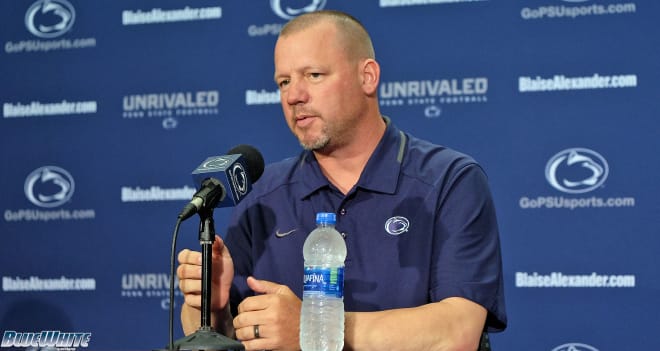For Nittany Lions, Advance Planning Eases Field Goal Decision-Making
The proposition was as cut-and-dry as they come.
Interviewing Penn State special teams coordinator Joe Lorig last month in advance of Blue White Illustrated's preseason magazine, the veteran assistant was asked to detail Penn State's choice to have Jake Pinegar kick field goals from shorter distances and Jordan Stout take the longer ones.
More specifically, Lorig was asked whether or not the Nittany Lions actually had a hard-and-fast number in mind delineating that distinction.
In fact, there is.
"Only because it's easy to remember; 32-and-in is Pinegar, 32-and-out is Stout," Lorig said. "You just chart that during fall camp. And the numbers just showed that barely. Even inside of the 32-yard line, they're really close. It was like Jordan had one or two more outside of that range than Jake, and we really wanted Jake to have great improvement and be really a pinpoint accurate shooter, like a SWAT guy."

But, what if the circumstances were extenuating? What if, with three seconds left to play in the game, trailing by two points, Penn State had the ball at the 32-and-a-half? And what if, through the course of the game, Jake Pinegar had already made four field goals and Stout hadn't yet kicked one?
"32-and-in is Pinegar," Lorig said. "32-and-a-half and out is Stout."
That simple.
But the process behind it, while also simple, draws from a wealth of data and, ultimately, planning between Lorig and head coach James Franklin. Not unlike other personnel decisions that are made at every position on offense, defense, and special teams, Penn State has a plan in place so that heat-of-the-moment choices can largely be avoided.
"We agree on it beforehand," Lorig said. "It's a funny question, but what if that situation does come up? We meet every Saturday morning before the game and that's one of the things that Coach Franklin does. Every position goes around, but he'll say okay, Coach Lorig, tell me exactly what are the parameters of our kickers?
"I know we're joking, and I'm with you, but literally, if it was on the 32-and-a-half, well, we've made that decision before all the pressure came up because it'd be hard for any of us with three seconds left, 107,000 fans. I want to win as bad as anybody around, believe me. And that's why you rely on the data that you've had going into that, so at the end of it, whether it's a make or a miss, it's not a random decision that was made at the last second based on all the junk that's going on."
Through the 2019 season, Lorig believed the strategy proved beneficial for Pinegar.
Coming off an up-and-down true freshman season at Penn State in which he converted 16 of 24 field goal attempts, with two blocked, Pinegar's sophomore effort was much improved. Taking on a halved workload, Pinegar sent home 11 of 12 field goals on the season, improving his conversion rate in the process.
"I think that helped him. It was Coach Franklin's idea, and I think it was part of Jake's improvement," Lorig said. "He didn't have to worry about the long stuff, just get really, really, really good at being pinpoint accurate at the tight stuff, which is almost always what happens.
"But kicking is a mental game. I really think that was part of his development and improvement, as it allowed him to just focus on 'Oh, this is the easy stuff, man. I got this.'"
Stout, meanwhile, attempted only three field goals on the year, all above 50 yards, hitting 2 of 3. He opened the year with a made 53-yarder against Idaho and followed it with a school-record 57-yarder in Penn State's 17-10 win against Pittsburgh in the third game of the season.
Ready for a reset ahead of the 2020 season, Lorig said the concept of choosing the best option for the job will garner the same approach from Penn State's coaching staff.
"It's based on the data," Lorig said. "And if the data over a year and a half shows us that outside the 32-yard line... we got a half a percentage point more with Jordan, then that's who we're going with. If it's a 10th of a percentage point more with Jake, then that's who we're going with. It's not an emotional decision at that point. It's already been made by the data and then you can live with the results."
*******
• Talk about this article inside The Lions Den
• Watch our videos and subscribe to our YouTube channel
• Learn more about our print and digital publication, Blue-White Illustrated
• Follow us on Twitter: @BWIonRivals, @NateBauerBWI, @RivalsSnyder, @DavidEckert98
• Like us on Facebook
